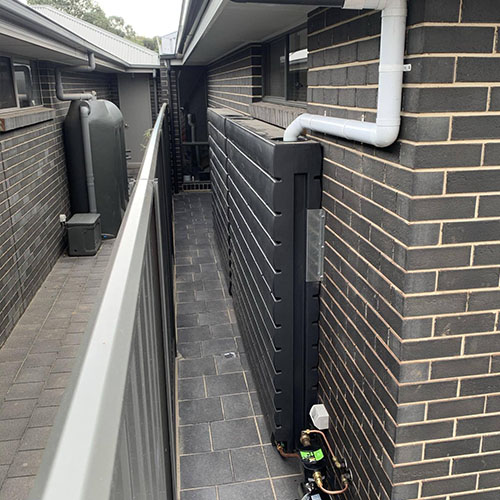Revealing the Perks of Rainwater Storage Tanks in Reducing Water Expenses and Ecological Effect
In a globe where sustainability and cost-efficiency are significantly crucial, the usage of rainwater tanks presents a sensible and eco aware remedy. The advantages of including rainwater containers right into property or industrial homes prolong past mere water costs decreases. By discovering the diverse advantages of such systems, one can discover a wide range of understandings right into how they contribute to a more sustainable future while favorably impacting both finances and the setting.
Cost Cost Savings Through Rain Containers
When considering the implementation of rainwater tanks, substantial price financial savings can be accomplished with effective water administration practices. Rainwater collecting supplies a lasting option that not only decreases water bills but additionally decreases the pressure on local water resources. By capturing and storing rain for different non-potable uses such as irrigation, commode flushing, and laundry, households and services can significantly decrease their dependence on cured water from the grid, resulting in significant cost financial savings with time.
By making use of gathered rainwater for tasks that do not call for drinkable water, such as watering yards or washing cars, individuals can decrease their overall water intake from the mains supply, resulting in lowered water costs. In addition, rain tanks can help minimize the effect of water constraints or droughts by giving an alternate water resource for vital jobs, guaranteeing connection in water supply without incurring excessive expenses.

Environmental Effect Reduction
Executing rainwater tanks not only results in cost savings but additionally adds dramatically to lowering the ecological influence related to water usage. By recording rain that would otherwise escape into storm drains, rainwater tanks help ease pressure on traditional water resources like rivers and tanks. This reduced need for municipally treated water brings about power cost savings and a decline in the carbon footprint related to water therapy and distribution procedures.
Moreover, using rain for activities such as horticulture, irrigation, and cleaning minimizes the need for making use of cured water for non-potable functions. This conservation of safe and clean water helps in protecting water sources for important uses and reduces the energy-intensive procedures associated with treating water to satisfy drinking criteria.

Water Expense Decrease Perks
The installment of rain tanks uses significant monetary benefits with reductions in water expenses. By accumulating and keeping rainwater for different home uses, such as watering gardens, flushing commodes, or doing laundry, home owners can substantially decrease their dependence on the metropolitan supply of water. This, in turn, causes a visible drop in water usage from typical sources, leading to reduced water costs at the end of each invoicing cycle.
Rain is a cost-free and lasting resource that can supplement and even change the requirement for utilizing cured water for non-potable objectives. Therefore, homes with rainwater tanks can read here see a considerable decrease in their overall water costs in time. Additionally, during periods of water limitations or drought, having a rain container can provide a useful alternate water source, further decreasing the dependence on expensive metropolitan water materials.
Basically, spending in a rain storage tank not just contributes to environmental conservation but likewise offers concrete financial advantages by reducing water bills and advertising lasting cost financial savings for homeowners.
Lasting Water Monitoring Solutions
Given the economic benefits and minimized dependence on metropolitan water products that rainwater containers give, discovering sustainable water management remedies comes to be a logical next step for property owners looking to optimize their water usage. By utilizing rainwater storage tanks to catch and store rain, homeowners can lower their dependancy on traditional water resources, such as municipal supplies or groundwater, therefore contributing to water conservation initiatives.

In enhancement to rainwater harvesting, sustainable water administration options might consist of implementing water-efficient devices, components, and landscape design practices. By adopting these lasting water management strategies, homeowners can not only enhance their water use yet also contribute to environmental preservation and reduce their water expenses in the lengthy run.
Area Water Resource Conservation

Furthermore, area participation can reach the application of water-saving innovations and methods on a larger range. Motivating the adoption of rainwater tanks, greywater recycling systems, and reliable watering approaches within neighborhoods can cause significant decreases in water usage. Furthermore, cultivating a sense of cumulative duty for water conservation can promote sustainable habits and resource practices among neighborhood participants.
Moreover, community water source conservation efforts can lead the means for stronger bonds among residents and a read this shared commitment to ecological stewardship. By interacting to safeguard and preserve water sources, communities can contribute substantially to a more sustainable and resistant future.
Final Thought
Finally, rainwater containers offer considerable cost financial savings, environmental benefits, and add to lasting water monitoring services. By reducing water costs, preserving water resources, and minimizing environmental impact, rainwater containers play a crucial role in promoting water conservation and sustainability - Slimline water tanks. Their implementation not just advantages private houses but additionally adds to the wider goal of area water resource management and preservation
Comments on “Affordable Slimline Water Tanks: Enhance Your Rainwater Harvesting”